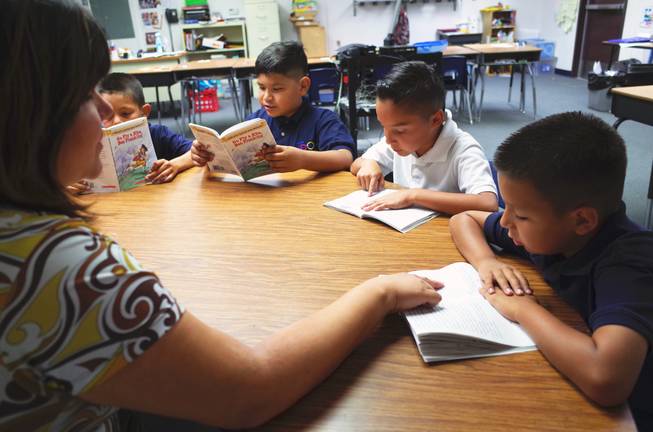
Cortez Elementary School teacher Shasta Thompson reads with third graders (l-r) Isaiah Corona, 9; Uziel Umana, 9; Rafael Lucio, 9; and Reily Armenta, 8; on Monday, June 22, 2014. Cortez is one of 14 “Zoom Schools” in Clark County that is receiving 17 additional days of school this year to help English-language learner students retain their literacy skills over the summer.
Tuesday, June 23, 2015 | 2 a.m.
Most people are familiar with a few statistics when it comes to the Clark County School District: It’s the fifth largest in the nation, and one of the worst performing.
But Clark County is also home to one of the country’s largest populations of English-language learners, a term given to students — many of whom come from recently arrived immigrant families — who are behind their peers in learning English.
Nearly 70,000 students in CCSD are ELL, a full 22 percent of the entire student population. Nationally, they make up just 10 percent of all students.
Many arrive in the classroom without an understanding of the social and cultural norms of their new country, not to mention the language. As a result, they require special attention from teachers and staff. Otherwise, they can easily fall through the cracks.
That’s where Ignacio Ruiz comes in. He was hired as CCSD’s ELL program director in April and finished his first full week on the job Friday. He comes from Tucson Unified School District in southern Arizona.
We sat down with Ruiz to talk about his approach to the job and why ELL programs are so necessary. His responses have been edited for length and clarity.
Las Vegas Sun: What exactly is an ELL student?
Ruiz: As soon as a new student registers in the district, we ask basic questions in regards to language. It’s called the Home Language Survey and we offer it to everyone by law. If any of those answers are any language other than English, then a screener looks at those students to see if they need any help.
ELL students come to us at all levels of language ability. A level 1 ELL student is not going to be able to write you an essay on something that they’ve read. But they will be able to provide you illustrations, or an oral report, et cetera. So you can still engage the student at grade level, but differently. The challenge then becomes how we can change the instruction to fit those students.
What are CCSD’s priorities for ELL right now?
I like to say that we have all these big rocks we have to move, but right now we really have to have a master plan. We need a map that we’re going to be able to look at say, “this is the current state of our district at this point.” It’s going to be key to how we move forward and build those systems of support.
What does a successful ELL program look like?
A successful ELL program is going to have highly trained teachers that know how to develop language in students. At any proficiency level students come in at, the teachers need to be able to deal with that.
The other piece is we have to celebrate their first language. We need to honor that and not see it as a deficit for a child to come in without knowing English. The more proficient you are in your first language, the easier and faster it is to obtain that second language. When you’re not proficient in your first language, it’s going to be a lot more difficult.
What’s the end goal of all this?
The goal is that when our kids leave our district, they have options. We’re only as good as everyone that’s a part of the community. Ensuring that for all of our students — including our ELLs — language does not limit what options they have. The ultimate goal is that they attain the language, but they also don’t lose the cultural awareness. We want to produce bilingual students, but it’s something that doesn’t happen overnight.


Join the Discussion:
Check this out for a full explanation of our conversion to the LiveFyre commenting system and instructions on how to sign up for an account.
Full comments policy